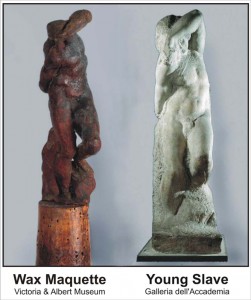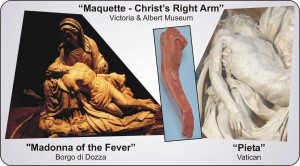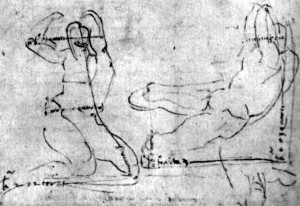Choosing your marble is reminiscent of school yard play…. Finding that precious stone… playing Indiana Jones… But now that you have dusted yourself off and have the block placed in your studio. Its time to get busy.
Designing your masterpiece through pencil and clay sketches is where the true work begins. The ability to discipline yourself to the task of creating a Maquette separates the Master from the Novice. Long before you can apply your muscles to the hammer and chisel, you will need to lovingly caress and model clay.
I know that for many, there will be the temptation to jump right in and start swinging at stone… and for the contemporary artist this may be the best way to coax shapes and curves from the natural grain that the stone presents.
However, if you are interested in realism… in the Renaissance tradition, mastering the maquette is necessary, and if done well, can be financially rewarding.
Michelangelo always made models. In fact, for each scale maquette of a future marble statue, he would additionally create two smaller sketch models (bozzetto). The first as a charcoal sketch, the second in wax or terrasecca (unfired clay)
So important was the modelling process to Michelangelo that he often and publicly lamented on how artist of his generation failed to develop the ability to sketch their work in advance.
It was the model that freed the artist to unbridled natural limitations of fluid form…. The clay body can be torqued to its extremes with confident twists from one angle to the next. Arm back, angled up, torso arched, neck tilted, all in endless manipulations to find that unique final expression.
The artist is freed from bodily limitation… impossible poses can be held indefinitely. This is what gives the stone movement and flight.
Marble carving is unforgiving. As a reductive process, once the stone is removed, there is no going back. A small miscalculation can lead to a change in angle that could throw off the complete symmetry of the final piece.
Michelangelo would create countless limbs in a various poses that could be used over and over again for different statues and frescos. Key sections could be modelled in advance to ensure the supple curves would be carved faithfully to plan.
At this point it would be very easy for us to get down on ourselves for not being as perfect as Michelangelo. Of course there is no such thing as perfection and if you look closely, you can spot hundreds of ‘anomalies’ in the Master’s work. My favourite charcoal sketch of his is the ‘working drawing’ that may have been an early rendering of his masterpiece Night in the Medici Chapel, Florence.
I am sure that Michelangelo would have been mortified for this rough sketch to be viewed publicly. After all, he was careful to destroy the bulk of his rudimentary work that he thought didn’t represent his talents. But the simplicity of this bozzeto, and the small wax model of the Slave fastened atop a cork, illustrates the point that initial sketches should be done quickly and in free form. Perfection should be reserved for the final Maquette.
And so, after examining my marble block and noting the flaws and determining cut lines, I can lose my inner visioning… What do I see in my stone?



